Posts Tagged ‘alopecia areata’
Friday, October 7th, 2011
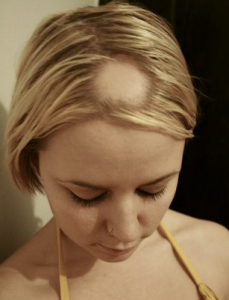 The autoimmune condition known as Alopecia causes hair loss in different areas of the body. These patchy, bald areas tend to look normal and don’t show any signs of inflammation or irritation. There is a genetic correlation found in some cases which can be linked to other autoimmune disorders. This particular form, Alopecia Areata, is most commonly a disease which is self-limiting, yet can be treated if necessary through steroid injections or topical medications by a dermatologist. The autoimmune condition known as Alopecia causes hair loss in different areas of the body. These patchy, bald areas tend to look normal and don’t show any signs of inflammation or irritation. There is a genetic correlation found in some cases which can be linked to other autoimmune disorders. This particular form, Alopecia Areata, is most commonly a disease which is self-limiting, yet can be treated if necessary through steroid injections or topical medications by a dermatologist.
The other form is known as Traction Alopecia which is common in children. This is a condition which is seen mainly in girls by having weak and fragile hair follicles. A common cause for this type of alopecia is tightly wrapped ponytails which in most cases affect the sides and front of the scalp. The initial sign of Traction Alopecia can be the elevation of the hairline. A way to treat this is by cutting the hair short and eliminating the strain the tightly wrapped hair causes on the follicles. The recovery time may take a few months and is spontaneous. In some of the longer term cases of Traction Alopecia, hair follicles are permanently damaged and a hair transplantation would be necessary to grow hair in the balding areas.
Tags: alopecia, alopecia areata, hair follicles, Traction Alopecia
Posted in Uncategorized | No Comments »
Wednesday, March 3rd, 2010
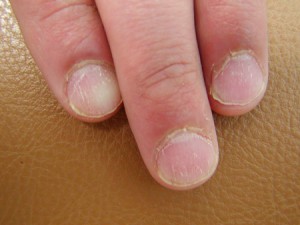 I’m a man living with Alopecia Universalis, which hasn’t been an issue from an aesthetic perspective since I’m 68 years old, secure with myself and where I’m at in life, and possess an optimistic perspective about life and believe in a higher power at work in the world. But, there is one issue disturbing me, my finger nails and toe nails. The nail bed has pits and seems to be eroding. I don’t know what options I have at this point. I tried having my nails coated with acrylic at a nail salon and, for a majority of the time, it seems to be good enough for me until they grow long and break. I’m a man living with Alopecia Universalis, which hasn’t been an issue from an aesthetic perspective since I’m 68 years old, secure with myself and where I’m at in life, and possess an optimistic perspective about life and believe in a higher power at work in the world. But, there is one issue disturbing me, my finger nails and toe nails. The nail bed has pits and seems to be eroding. I don’t know what options I have at this point. I tried having my nails coated with acrylic at a nail salon and, for a majority of the time, it seems to be good enough for me until they grow long and break.
To aid in restoring my nails, I’m wondering if I ought to be taking vitamin pills, like Biotin or Zinc?
Thank you and please advise,
-
A:
Thanks for your email. I love your attitude about Alopecia Universalis. Alopecia Universalis is a more severe type of Alopecia Areata. You ask a good question. Personally, I searched and didn’t find an answer every place I looked. It was a topic of conversation with a few of my dermatologist friends (when nail health is involved, dermatologists are familiar with this condition and I think they’ve seen or dealt with comparable cases of Alopecia Universalis or Alopecia Areata nail deterioration).
I did find two answers that might be of help to you, though.
1. Well, I’ve seen a good number of people with major deformities of their nails, including dents, flaking, rippled nails, and distal phalanges with granulation tissue, symptoms which started after these people went in for acrylic manicures. The nails end up becoming kind of rough and the nail beds get damaged.
2. Hey Doc! Unfortunately, there’s not much a person can do about treating the nail pitting that is a part of having Alopecia Universalis or Alopecia Areata. A person can coat it with acrylics, that’s OK, but acrylics will, without a doubt, further corrode the nail bed over the long haul. It’s better to use nail polish or manicure the nails. Taking Biotin is OK if a person is trying to have healthier-looking nails, but it’s not the solution to the underlying problem. There’s also the option of taking topical steroids to see whether that makes any kind of difference. Good luck.
Tags: alopecia areata, nail changes with alopecia
Posted in hair loss complications | No Comments »
Tuesday, January 19th, 2010
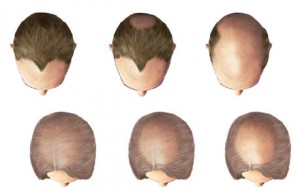
Q:
Hey Dr. Parsa Mohebi,
I’m grateful you took time out to see me on Saturday. The letter that gave a summary of what we talked about was very thorough and I just wanted to say thanks for that.
Since the last time we met, I did some of my own research and came up with a few queries:
1) When it comes to giving a name to my hair loss pattern, is Alopecia the correct way to describe it?
2) Would a Cortizone shot be an option for me?
3) Is laser therapy OK?
4) If I happen to use minoxidil, I’m wondering if it has to be 2% or would a higher percentage result in more hair growth and faster hair growth?
5) I was told to receive a complete medical evaluation, do you know of a doctor I can go to? I want someone I can trust.
Thanks again for taking the time to see me and also to accommodate my questions.
Sincerely,
Stephen
-
A:
Hello Stephen,
I’ve provided answers to your questions in chronological order.
1) When it comes to giving a name to my hair loss pattern, is Alopecia the correct way to describe it?
Alopecia, literally, would be defined as hair loss. There are many different types of alopecia or hair loss, such as male patterned alopecia or female patterned alopecia or alopecia cicatricial. I believe the pattern on your head is a male pattern since hair was lost in the frontal area as you kept hair on the donor area intact. This is the reason you may be a potential candidate for a hair transplant since your medical evaluation stated that you’re not medically treatable for hair loss.
2) Would a Cortizon shot be an option for me?
Absolutely not. But steroid shots are sometimes used for Alopecia Areata (AA), which is an autoimmune disorder. Alopecia Areata is a hair loss condition with patchy hair loss spots. Your condition is not Alopecia Areata.
3) Would you consider laser therapy?
I do not recommend laser therapy for hair loss in the form of laser comb or laser machines because of the lack of solid medical evidence that support their effectiveness at this time.
4) If I were to use Monoxidil, does it have to be 2% or a higher percentage would yield more and faster hair growth?
You can start with 2% and then you need to be re-evaluated in six to 12 months and a treatment plan might need to be adjusted at that time.
5) you recommended a complete medical evaluation, could you please recommend someone that you trust?
Any good internist or endocrinologist could follow through with the lab works that you need. Our letter includes the list of medical conditions that should be considered and lab works to rule out those women like you who have hair loss. You can share my letter with any good internist or endocrinologist and he or she should be able to follow through with your lab result and treat any treatable conditions that could possibly be found.
Have a great day,
Tags: alopecia areata, hair loss, hair loss pattern, hair loss treatment, laser therapy, laser therapy for hair loss, minoxidil
Posted in Bakersfield hair transplant, California hair transplant, hair loss medication, hair loss products, hair transplant, men hair restoration, Newport Beach hair transplant, Orange County hair transplant | No Comments »
Saturday, September 5th, 2009
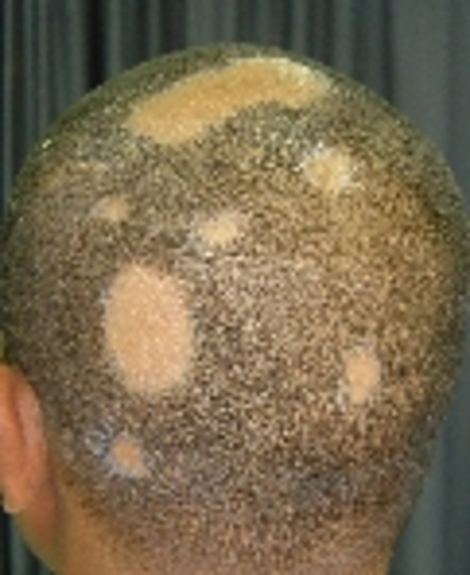 Alopecia Areata (AA) is an autoimmune hair loss condition. It presents itself in the form of patchy hair loss on the scalp or other areas where hair exists. Some have questioned if AA can also be triggered by emotional stress. It has been discussed in some medical journals but the exact mechanism has never been explored. There has been a study conducted and published on the relationship between stress and the pathogenesis of alopecia areata. This was done by subjecting AA-affected and normal lab mice to ether anesthesia (stress) through restraining the animal. Alopecia Areata (AA) is an autoimmune hair loss condition. It presents itself in the form of patchy hair loss on the scalp or other areas where hair exists. Some have questioned if AA can also be triggered by emotional stress. It has been discussed in some medical journals but the exact mechanism has never been explored. There has been a study conducted and published on the relationship between stress and the pathogenesis of alopecia areata. This was done by subjecting AA-affected and normal lab mice to ether anesthesia (stress) through restraining the animal.
The mice with alopecia areata had a marked increase in hypothalamic-pituitary-adrenal tone and activity centrally and peripherally in the skin and lymph nodes. Plasma corticosterone, adrenocorticotropic hormone, and estradiol levels were determined in this study as indicator or stress level, whereas gene expression in brains, lymphoid organs, and skin was measured by quantitative RT-PCR for corticotropin-releasing hormone, arginine vasopressin, proopiomelanocortin, glucocorticoid receptor, mineralocorticoid receptor, corticotropin-releasing hormone receptor types 1 and 2, interleukin-12, tumor necrosis factor-alpha, and estrogen receptors type-1 and type-2.
Compared to normal mice, there was an altered interaction seen between the adrenal and gonadal axis proving that the stress level in those animals was in fact higher. Stress also caused changes in the activity of the hypothalamus pituitary axis in the mice with AA.
In addition, animals with AA had significantly blunted corticosteroid and ACTH responses to acute ether stress (physiological stressor) and a deficit in habituation to repeated restraint stress (psychological stressor). These findings further suggest that altered brain responses caused by stress may be associated with the occurrence of alopecia areata, proving the hypothesis that stress plays an important factor.
Treatment of AA is done through observation of the patient and, in some cases, steroid injections can also prove useful. These treatment options have shown some improvement in those who have extensive types of AA like Alopecia Totalis. We do not recommend any patient to get hair transplant surgery if they have active AA since the chance of losing the newly transplant hair is very likely.
Although AA is not genreally treated with hair restoration, we at our offices of US Hair Restoration in LA, BH and Orange County visit and treat patients of AA in a regular basis.
Tags: AA, ACTH, adrenocorticotropic hormone, alopecia areata, alopeica totalis, arginine vasopressin, Avp, CORT, corticotropin-releasing hormone, estradiol, glucocorticoid receptor, hair loss, hair loss innovations, hair transplant, hair transplant surgery, lymphoid organs, mineralocorticoid receptor, proopiomelanocortin, RT-PCR, sress level
Posted in Beverly Hills hair transplant, California hair transplant, Los Angeles Hair Transplant, Orange County hair transplant | No Comments »
Saturday, April 18th, 2009
One of our readers who is in her 30s has asked about Alopecia Areata or AA. She says she has been using may different treatment either medical or herbal for her patchy hair loss in the last 20 years. She continues as: Hairs goes in patches from all over the body including eye brow and eye lashes, but additional thing with me is that I feel itching on the place from where hairs are going to fall with pain on the itching area too, then consequently within 1-2 days hairs falls and leaves red patch behind pains also gets disappeared.
After that I start using Diprovate lotion twice daily on affected area. Hair comes within month then I stop using Diprovate. But normally hair length goes to only 8-10 inches and then again hair loss same process going on since 1980. One thing I observed is that places of hair loss patches are almost fixed. One thing I also used some hormonal injections too but as usual no permanent remedy. Do you also feel pain before falling of hair on the place of hair fall on the scalp? Generally I felt pain on scalp only though hair loss periods. Pain is only on scalp.
Having the episodes of patchy baldness could be the first sign of alopecia areata. Although hair loss in a patchy form is usually considered alopecia areata or AA, the condition of this hair loss patient is not a typical one. Alopecia areata is usually painless and the changes in skin shape and color is not that noticeable except for the hair loss. There are some other hair loss conditions that may present themselves as patchy hair loss such as Cicatricial Alopecia in which an inflammatory reaction causes hair loss.
A hair loss diagnosis could be established through direct examination and biopsy of the scalp from hair loss lesions. My recommendation to this hair loss patient or anyone with similar balding problem is to visit a good dermatologist to confirm the diagnosis of this patchy hair loss condition. Hair transplant is generally not indicated in many types of patchy hair losses, but a hair transplant doctor can discuss it further after examining patient’s scalp and hair or possibly scallp biopsy results.
Tags: alopecia, alopecia areata, alopecia cicatricial, patchy hair loss
Posted in hair loss medication, hair transplant, women hair loss | No Comments »
Tuesday, February 24th, 2009
We received an email from one of our overseas patients in regards to his patchy hair loss. He describes that he has experienced these episodes since the age of 12 years. He is now 36 years old. They had attested his patchy hair loss to Alopecia Areata (AA) but his hair loss which was seen all over his body also included swelling, pain and discoloration. Throughout the years he had been prescribed with different types of topical medications as well as a hormonal injection treatment. All of these treatments did not permanently correct his situation but in most cases did give him temporary relief.
Our best assessment is that although he is experiencing patchy hair loss as is seen in Alopecia Areata (AA) this condition is normally painless and skin shape and color remain the same. Other forms of hair loss conditions with similar symptoms as his are more closely related to Alopecia Cicatricial. This skin condition inflames the affected area and causes hair loss in that same affected area. A good dermatologist can best diagnose these types of skin conditions by means of biopsy. After the assessment we can then give you the best plan of attack for future hair restoration.
If you have any similar questions on hair loss and hair restoration, please contact us through our California Hair Restoration website.
Tags: alopecia, alopecia areata, alopecia cicatricial, patchy balding, patchy hair loss
Posted in men hair restoration, Orange County hair transplant | No Comments »
Monday, December 29th, 2008
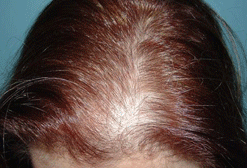 Female hair loss I have been often asked this hair loss question on alopecia areata and other hair loss disorders during pregnancy in our Los Angeles hair transplant and Orange County hair restoration clinics. Here is one more female hair loss question about alopecia areata during pregnancy. The question is coming from one of my patients from our Los Angeles, Orange County hair transplant clinic who said she was diagnosed with Alopecia and lost pretty much all of her hair during pregnancy. Her son is now 5 months old and her hair has grown back. All but one spot. She said that she could hide the balding spot, but I would love for one day not to have to hide it.
This woman has experienced extensive hair loss, but she grew her hair back after only a few months, which is a great recovery for such a hair loss condition that could potentially lead to a much worse outcome. My suggestion to this patient was to be patient and to hang in there. It is very likely that this patient can grow the rest of her hair back without any hair loss treatment. If her hair loss was due to alopecia areata, a hair transplant cannot help her balding condition. Female hair loss during pregnancy and after delivery can recover spontaneously. However, she would need to be seen and examined by a hair specialist to confirm the diagnosis of her hair loss condition properly.
After pregnancy, women may lose hair due to a common condition called telogen effluvium that should not be mistaken with other hair loss disorders. Telogen effluvium is a common cause of hair loss in women after delivery of a baby or some other conditions. Telogen effluvium is a self limiting hair loss condition and does not need medical treatment and definitely not hair transplant surgery.
Tags: alopecia areata, female hair loss, telogen effluvium, women hair loss
Posted in women hair loss | No Comments »
|
|
 The autoimmune condition known as Alopecia causes hair loss in different areas of the body. These patchy, bald areas tend to look normal and don’t show any signs of inflammation or irritation. There is a genetic correlation found in some cases which can be linked to other autoimmune disorders. This particular form, Alopecia Areata, is most commonly a disease which is self-limiting, yet can be treated if necessary through steroid injections or topical medications by a dermatologist.
The autoimmune condition known as Alopecia causes hair loss in different areas of the body. These patchy, bald areas tend to look normal and don’t show any signs of inflammation or irritation. There is a genetic correlation found in some cases which can be linked to other autoimmune disorders. This particular form, Alopecia Areata, is most commonly a disease which is self-limiting, yet can be treated if necessary through steroid injections or topical medications by a dermatologist.



